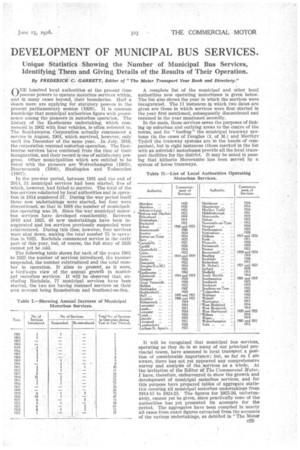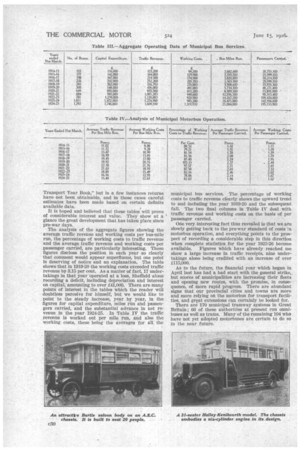DEVELOPMENT OF MUNICIPAL BUS SERVICES.
Page 11

Page 12

If you've noticed an error in this article please click here to report it so we can fix it.
Unique Statistics Showing the Number of Municipal Bus Services, Identifying Them and Giving Details of the Results of Their Operation.
By FREDERICK C. GARRETT, Editor of "The Motor Transport Year Boole and Directory."
('NE hundred local authorities at the present time IL/possess powers to operate motorbus services within, and in many cases beyond, their boundaries. Half a 'dozen more are applying for statutory powers in the present parliamentary session (1926).. It is common knowledge that municipal authorities figure with prominence among the pioneers in motorbus operation. 'The history of the Eastbourne undertaking, which commenced in 1902 with four vehicles, is. often referred to. The Southampton Corporation 'actually commenced a service in August, 1901, which survived, however, only wail the December of the same year. In July, 1919, the corporation resumed motorbus operation. The Eastbourne services have continued from the time of their inauguration, and their record is one of satisfactory progress. Other municipalities which are entitled to be listed with the pioneers are Wolverhampton (1905), Bournemouth (1906), Haslingden and Todmorden (1907).
In the pre-war period, between 1901 and the end of 1914, 31 municipal services had been started, five of which, however, had failed to survive. The total of the bus services conducted by local authorities and in operation in 1914 numbered 27: During the war period itself three new undertakings were started, but four were discontinued,zso that in 1918 the number of municipalities operating was 26. Since the War municipal motorbus services have developed considerably. Between 1919 and 1925, 43 new undertakings have been inaugurated and ten services previously suspended were teintroduced. During this time, however, four services were shut down, making the total number 75 in operation in 1925. Rochdale commenced service in the early part of this year, but, of course, the full story of 1926 cannot yet be told.
The following table shows for each of the years 1901 to 1925 the number of services introduced, the Dumber suspended, the number reintroduced and the total number in operation. It aims to present, as it were, a bird's-eye view. of the annual growth in municipal motorbus services. It mill be observed that, excluding Rochdale, 77 municipal . Services have been started, the two not having resumed Services on their own acceunt being Itainsbotfom and Southend-on-Sea. A complete list of the municipal and other local authorities now operating motorbuses is given below. The list also shows the year in which the services were inaugurated. The 11 instances in which two dates are given are those in which services were first started in the year first mentioned, subsequently discontinued and resumed in the year mentioned secondly.
In the main, these services serve the purposes of linking up suburban and outlying areas to the centre of the towns, and for " feeding" the municipal tramway systems (in the cases of Douglas (I. of M.) and Merthyr Tydvil the tramway systems are in the hands of companies), but in eight instances (those marked in the list with an asterisk) motorbuses provide all the local transport facilities for the district. It may be noted in passing that hitherto Morecambe has been served by a system of horse tramways.
It will be recognized that municipal bus services, operating as they do in so many of our principal provincial towns, have assumed in local transport a position of considerable importance; but, so far as I am aware, there has not yet appeared any comprehensive survey and analysis of the, services as a whole. At the invitation of the Editor Of The Commercial Motor, I have, therefore, endeavoured to show the growth and development of municipal motorbus services, and for this purpose have prepared tables of aggregate statistics covering all municipal motorbus undertakings from 1914-15 to 1924-25. The figures for 1925-26, unfortunately, cannot yet be given, since practically none of the authorities has yet presented its accounts for the period. The aggregates have been compiled in nearly all cases from exact figures extracted from the accounts of the various undertakings, as detailed in "The Motor
Transport Year Book," but in a few instances returns have not been obtainable, and in these cases careful estimates have been made based on certain definite available data.
It is hoped an-d believed that these tables will prove of considerable interest and value. They show at a glance the great development that has taken place since pre-war days.
The analysis of the aggregate figures showing the average traffic revenue and working costs per bus-mile run, the percentage of working costs to traffic revenue and the average traffic revenue and working costs per passenger carried, are particularly interesting. These figures disclose the position in each year so clearly that comment would appear superfluous, but one point Is deserving of notice and an explanation. The table shows that in 1919-20 the working costs exceeded traffic revenue by 3.15 per cent. As a matter of fact, 17 undertakings in that year operated at a loss, Sheffield alone recording a deficit, including depreciation and interest on capital, amounting to over £41,000. There are many points of interest in the tables which the reader will doubtless perceive for himself, but we would like to point to the steady increase, year by year, in the figures for capital expenditure, miles run and passengers carried, and the substantial advance in net revenue in the year 1924-25. In Table IV the traffic revenue is worked out per mile run, and also the working costs, these being the averages for all the
municipal bus services.percentage of working
costs to traffic revenue early shows the upward trend to and including the year 1919-20 and the subsequent fall. The two final columns in Table IV deal with traffic revenue and working costs on the basis of per passenger carried.
One very interesting fact thus revealed is that we are slowly getting back to the pre-war standard of costs in motorbus operation, and everything points to the prospect of recording a considerable step in this direction when complete statistics for the year 1925-26 become available. Figures which have already reached me Show a large increase in traffic receipts, nine undertakings alone being credited with an increase of over £115,000.
As to the future, the financial year which began in April last has had a bad start with the general strike,. but scores of municipalities are increasing their fleets and opening new routes, with the promise, in consequence, of more rapid progress. There are abundant signs that our provincial cities and towns are more and more relying on the motorbus for transport facilities, and great extensions can certainly be looked for.
There are 170 municipal tramway systems in Great Britain ; 66 of these authorities at present run omnibuses as well as trams. Many of the remaining 104 who have not yet adopted motorbuses are certain to do so in the near future.




















































